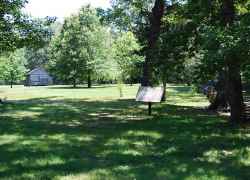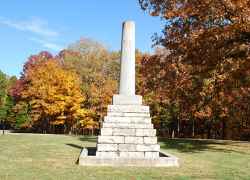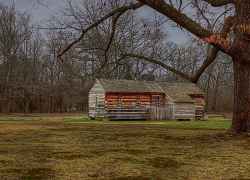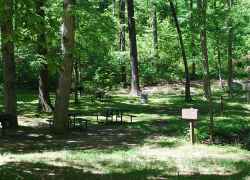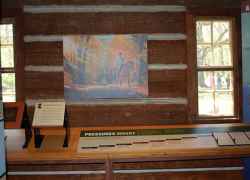In the Grinder House, the ruins of which are still discernible 230 yards south of this spot, his life of romantic endeavor and lasting achievement came tragically and mysteriously to its close on the night of October 11, 1809. The report of the committee appointed to carry out the provisions of the Monument Act contained these significant statements: "Great care was taken to identify the grave. George Nixon, Esq., an old surveyor, had become very early acquainted with the locality." He pointed out the place; but to make assurance doubly sure the grave was reopened and the upper portion of his skeleton examined and such evidence found as to leave no doubt this was the place of interment.
Natchez Trace - is plainly visible though long deserted. This road is a section of the Natchez Trace evolved from buffalo and Indian trails into the first national highway of the southwest. Cut and opened under authority of the United Sates government after treaties negotiated with the Chickasaw and Choctaw Indians in 1801. Designed to meet early necessities of trade between Nashville and the country of the lower Mississippi it is an abiding foot print of the bold, crude commerce of the pioneers. Yet it not without military significance in the history of our country. Over it passed part of the Andrew Jackson army in his campaign against the Creek Indians in 1813 and again on his return from the battle field of New Orleans in 1815. But before Talladega and New Orleans - before the soldiers of Jackson had given renown to the Natchez Trace, it received its immortal touch of melancholy fame when Meriwether Lewis journeying over it on his way to Philadelphia to edit the story of his great expedition, met here his untimely death on the night of October 11, 1809.
Grinder House - Site and ruins of the Grinder House in which Meriwether Lewis met his death on the night of October 11, 1809. Inside the Grinder House are exhibits depicting the significance of the Trace through its history and its chronology beginning in 1765, including the creation of the parkway in 1938 by and act of Congress.
Today, the Meriwether Lewis site includes a 32-site campground, pioneer cemetery, picnic tables, visitor information center, restrooms, exhibits, trails and a section of the Old Natchez Trace.
Hours of operation: During the spring, summer and early fall, the Meriwether Lewis Visitor Information Center is open Friday (from noon to 4:30 pm), and Saturday and Sunday (from 9:00 am to 4:30 pm). The visitor information center is closed Mondays through Thursdays.
Starting November 11, 2019 the Meriwether Lewis Visitor Information Center is closed for the winter.
The burial monument, pioneer cemetery, restrooms, campground, and hiking trails are open seven days a week all year.







